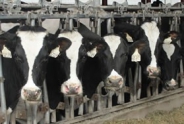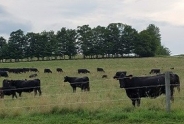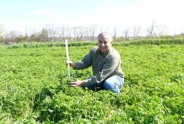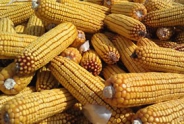GDDs September 25, 2020
Erik Smith, Area Field Crop Specialist/Team Leader
Central New York Dairy and Field Crops
For what should be the last time this year, here are the air Growing Degree Days (GDDs) that have accumulated to date from 13 locations across the team's 8-county area.
Growing Degree Days are Base 86/50 F and calculated by taking the average daily temperature, ((Daily Max Temp - Daily Min Temp)/2) - 50. But the maximum temperature cannot be more than 86 degree F and the minimum less than 50 degree F.
See: Growing Degree Calculator
Many of us experienced frost last weekend. We're not expecting another frost or freeze in the near future, but daily temps are difficult to predict more than 10-14 days out. Here's Cornell's weather blog with our short-term outlook, and here's an article regarding alfalfa harvest for those with difficult harvesting decisions to make after a frost or freeze. Also, here is a publication from Iowa State with information for those who may have experienced a hard freeze in their corn or soy before physiological maturity.
Silage harvest is beginning to wind down throughout the region, but:
We've noticed that fewer fields are being affected by the typical late-season foliar diseases this year, so green foliage may mislead you into thinking you still have time - so check your crop to make sure you're on schedule for silage harvest!
If you know your GDDs for your hybrid to physiological maturity (black layer) subtract off 150 GDDs to get you roughly the GDDs needed to silage harvest dry matter for that hybrid. However, tasseling dates serve as a better starting place to project corn silage harvest dates than planting dates. Silage harvest is likely to begin at about 800 GDDs after tasseling for 101-110 day hybrids and 750 GDDs for 96-100 day hybrids. Using the GDDs after tasseling to harvest and the Climate Smart Farming Website's 15 year GDD data it is possible to make projections as to when corn silage harvest might begin. Record Silking/Tasseling Dates for Corn Fields
Bunker silage should be ~65-70% moisture at harvest (30-35% DM), so if you have early-planted corn in some of the lower-lying areas (especially in the eastern part of the region this year!), take note of what stage you're at in the coming days and weeks:
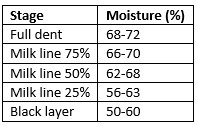
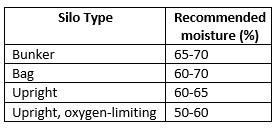
See the attached table for more of the September 25, 2020 results. See the attached pdf for a good guide on corn development and our reference for growth stages.
GDDs September 25, 2020 (pdf; 37KB)
Visual Guide to Corn Development (pdf; 21544KB)
Upcoming Events
Labor Roadshow IX
December 1, 2025
December 9 - December 10, 2025December 17 - December 18, 2025December 22, 2025
In-person and online events to keep NY's agricultural employers informed and prepared for today's labor challenges.
Inspired by Annie's: How to Be a Strong Woman Farm Manager
January 10, 2026
January 17, 2026
Free webinars geared towards women who own or operate a farm in NYS.
2026 Dairy Day
January 13, 2026 : Dairy Day - Hamilton
Hamilton, NY
Lunch included
January 14, 2026 : Dairy Day - Ballston Spa
Ballston Spa, NY
Lunch included
Announcements
Statewide Field Crop Pathology Needs Assessment Survey
Your input is wanted for identifying priorities!Sign Up for Our Weekly E-Newsletter
We send out a bi-weekly e-newsletter that has announcements, upcoming programs, and opportunities for you! Registration is quick, easy, and free. Click here to sign up today!Farmers Can Join MeatSuite For Free!
MeatSuite.com is a free resource provided by Cornell University where NY meat farmers can create a farm profile and list their bulk (wholes, halves, quarters) and bundled (i.e. Grilling Bundle) meat products.Why should farmers join?
1. It's free and easy!
2. Connect with more local customers. In the past year the MeatSuite.com farm directory had 8,300 visits from New York consumers. Farm profiles get as many as 25 views per month from potential local customers. We also spotlight MeatSuite farms on social media and bring attention and purchases to farms through highlights and giveaways.
How do I join?
Farmers can visit https://www.meatsuite.com/farmers/ to create a free farm profile. You must list at least one product for your farm's profile to go live. You'll also have access to Cornell's free Meat Price Calculator, a helpful tool for pricing your meat to make a profit.
While you're on MeatSuite, check out the "Creating Consumer-Friendly Bulk Meats" publication on the log-in page. It has tips on how to create bulk meat products that are easier for first-time buyers to say "yes" to.
If you have any questions as you create your farm profile or products, we're here to help! Please email Matt LeRoux at mnl28@cornell.edu.

